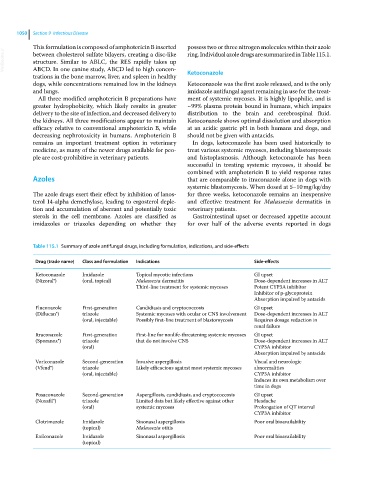Page 1112 - Clinical Small Animal Internal Medicine
P. 1112
1050 Section 9 Infectious Disease
This formulation is composed of amphotericin B inserted possess two or three nitrogen molecules within their azole
VetBooks.ir between cholesterol sulfate bilayers, creating a disc‐like ring. Individual azole drugs are summarized in Table 115.1.
structure. Similar to ABLC, the RES rapidly takes up
ABCD. In one canine study, ABCD led to high concen
trations in the bone marrow, liver, and spleen in healthy Ketoconazole
dogs, while concentrations remained low in the kidneys Ketoconazole was the first azole released, and is the only
and lungs. imidazole antifungal agent remaining in use for the treat
All three modified amphotericin B preparations have ment of systemic mycoses. It is highly lipophilic, and is
greater hydrophobicity, which likely results in greater ~99% plasma protein bound in humans, which impairs
delivery to the site of infection, and decreased delivery to distribution to the brain and cerebrospinal fluid.
the kidneys. All three modifications appear to maintain Ketoconazole shows optimal dissolution and absorption
efficacy relative to conventional amphotericin B, while at an acidic gastric pH in both humans and dogs, and
decreasing nephrotoxicity in humans. Amphotericin B should not be given with antacids.
remains an important treatment option in veterinary In dogs, ketoconazole has been used historically to
medicine, as many of the newer drugs available for peo treat various systemic mycoses, including blastomycosis
ple are cost‐prohibitive in veterinary patients. and histoplasmosis. Although ketoconazole has been
successful in treating systemic mycoses, it should be
combined with amphotericin B to yield response rates
Azoles that are comparable to itraconazole alone in dogs with
systemic blastomycosis. When dosed at 5–10 mg/kg/day
The azole drugs exert their effect by inhibition of lanos for three weeks, ketoconazole remains an inexpensive
terol 14‐alpha demethylase, leading to ergosterol deple and effective treatment for Malassezia dermatitis in
tion and accumulation of aberrant and potentially toxic veterinary patients.
sterols in the cell membrane. Azoles are classified as Gastrointestinal upset or decreased appetite account
imidazoles or triazoles depending on whether they for over half of the adverse events reported in dogs
Table 115.1 Summary of azole antifungal drugs, including formulation, indications, and side‐effects
Drug (trade name) Class and formulation Indications Side‐effects
Ketoconazole Imidazole Topical mycotic infections GI upset
(Nizoral®) (oral, topical) Malassezia dermatitis Dose‐dependent increases in ALT
Third‐line treatment for systemic mycoses Potent CYP3A inhibitor
Inhibitor of p‐glycoprotein
Absorption impaired by antacids
Fluconazole First‐generation Candidiasis and cryptococcosis GI upset
(Diflucan®) triazole Systemic mycoses with ocular or CNS involvement Dose‐dependent increases in ALT
(oral, injectable) Possibly first‐line treatment of blastomycosis Requires dosage reduction in
renal failure
Itraconazole First‐generation First‐line for nonlife‐threatening systemic mycoses GI upset
(Sporanox®) triazole that do not involve CNS Dose‐dependent increases in ALT
(oral) CYP3A inhibitor
Absorption impaired by antacids
Voriconazole Second‐generation Invasive aspergillosis Visual and neurologic
(Vfend®) triazole Likely efficacious against most systemic mycoses abnormalities
(oral, injectable) CYP3A inhibitor
Induces its own metabolism over
time in dogs
Posaconazole Second‐generation Aspergillosis, candidiasis, and cryptococcosis GI upset
(Noxafil®) triazole Limited data but likely effective against other Headache
(oral) systemic mycoses Prolongation of QT interval
CYP3A inhibitor
Clotrimazole Imidazole Sinonasal aspergillosis Poor oral bioavailability
(topical) Malassezia otitis
Enilconazole Imidazole Sinonasal aspergillosis Poor oral bioavailability
(topical)

